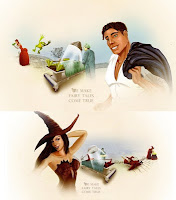It all started when
Baruch, a good friend and avid reader,
told me that he just finished reading “
The History of Amsterdam”. Since he
knows that as lawyer and writer I love a good murder mystery or
cause célèbre, he told me about a famous murder that took place
in the 17th century and was eternalized by Rembrandt in two drawings. Fascinated,
I started to research and found a compelling story that spans several centuries
and involves three women and one painter.
The story starts as follows.
Around April 14th, 1664 Danish Elsje Christiaens came to Amsterdam at the
age of 18. She was born in “Sprouwen”, which is quite likely Dutch for the
island of
Sprogo.
She wanted to work as a maid (or servant girl) and rented a place to sleep
in the cellar of a boarding house. At the end of the first month, the
manageress of the establishment came to collect the rent of one “daalder”
(€ 0,68 or US$ 0.89). However, Elsje was not able to pay, since she had
not been able to find any work yet.
The next day, the manageress asked again. At that point, the women started
to argue. The manageress threatened to confiscate her chest containing her (meager)
belongings. Their fight became physical when the manageress hit Elsje with a
broomstick. Elsje then grabbed an ax that was near the cellar and hit the
manageress on the head. The woman fell down the cellar stairs and died.
Elsje panicked, ran outside and jumped in the
Damrak (at that time the mouth
of the Amstel River). She was dragged out of the water and arrested. After two
interrogations, she was convicted on May 1, 1664. The execution was considered
to be fitting the crime: she was hanged in front of the town hall and the
executioner hit her several times with the murder weapon on her head.
The body was then transported to
Volewijck (at that time moor land that
contained a gallows field). Her body was tied to the gallows with the ax hanging
next to her head “
in order for air and birds to devour her”. When
Rembrandt
learned about the faith of Elsje Christiaens, he rowed over to Volewijck where
he made two drawings of the executed girl.
Centuries later, in the 1960s, archivist
Ms. I.H. van Eeghen became
fascinated by the two drawings. Although art historians dated the drawings
around 1655, she realized that none of the Rembrandt experts had ever bothered
doing any research in law archives to find out more about the subject of the
drawings.
She started to go through 25
years of recorded confessions and found out that the only woman ever to get the
death penalty at that time was a Danish maid called Elsje Christiaens.
Based on her findings, she was able to accurately date the drawings at the
beginning of May 1664. She was pleased as Punch that the lauded Rembrandt
experts erred 8-10 years with their dating, stating: “Elsje Christiaens, who
once served as an example to deter others from committing crimes, is now once again
serving as an example for art historians to be careful with their dating solely
based on style criteria!’
I find it amazing how a young immigrant that was executed two weeks after
entering a country in search of employment is talked about and blogged about
almost 450 years later......Furthermore, this story involves three women: the
murderess, the victim and the archivist.
I wonder....would Rembrandt have been amused?
Let me dedicate this blog post to another amazing woman who
encouraged me to write this post:
Gita Sterenson.
(Image: Rembrandt Harmensz. van Rijn 1606 – 1669, Elsje
Christiaens pen- en pencil drawings (17 × 9 cm) 1664)
 The Oxford American Dictionary and the Oxford English Dictionary have selected their respective word of the year.
The Oxford American Dictionary and the Oxford English Dictionary have selected their respective word of the year.























